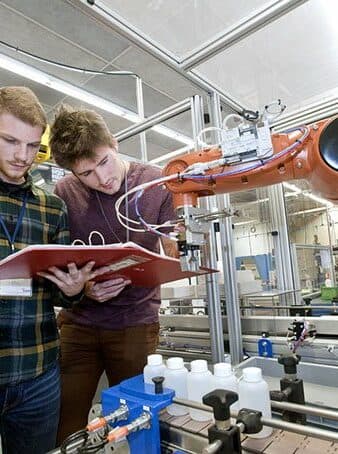The program lasts 18 weeks. Project topics are defined by the “Services to Business” department together with industry partners.
Students are assigned to topics in pairs of “junior consultants”. Selection criteria are as follows:
-
- students profiles and how their skills complement
- competences required to perform the project
- students’ preferences
Project workflow
The following R&D steps have to be performed by the junior consultants in order to design a robust and fitting solution to the initial problem:
-
- Conduct state of the art and benchmarking of the core technology or organizational topics
- Consultation with experts and service providers
- Field measurements and analysis
- Scientific and experimental probation of models
- Construction of prototypes
- Sustainability analysis and overall impact analysis of the solution
- Change management, communication and consultation with the company’s stakeholders, from technicians all the way to management
The table below gives a detailed view into a project roll-out:
|
PROJECT PROCESS
|
DETAIL CONTENTS
|
DELIVERABLES
|
|
Problem Definition
|
Assimilate the context and the issues for the company
Understand customer needs
|
Opportunity assessment
|
|
Situation Analysis
|
Identify resources
Identify constraints and risks
Define the objectives and validate them with the customer
Establish specifications
|
Feasibility Study
Risk Analysis
Specifications Summary
|
|
Choice of a strategy
|
Make a list of the strategic choices and choose a project strategy [securing, confidentiality, ethical choices …]
|
Strategic Document – Charter
Criteria for choice
|
|
Setup and Planning the Project
|
Create the Project Plan and Approach:
– Planning : validation stages, activities, expected deliverables
– Define and validate the working methods with all the stakeholders (internal, customer, external…)
– Gain perspective on the economic issues
– Define key performance indicators (KPIs) and management tools
|
Organization Chart
Planning
Financial set-up
|
|
Project Implementation
|
Implement the project
Use the follow-up indicators (technical, financial …)
Establish corrective action plans (evolution of needs, making up for delays, managing hazards …)
Manage communication with each one of the stakeholders
|
Dashboards
Intermediate deliverables and analysis
Operational reports
|
|
Synthesis
|
Manage the end of the project and handover
Check that the specifications correspond to the result
Make a report of the results of the project
Synthesize the technical and methodological inputs
Discuss future prospects
Extrapolate from experience
|
Written and oral syntheses of the results
Report and presentation to the customer
|
Students are in direct contact with the company representatives but have an Icam advisor or tutor who coaches and fosters the autonomy and efficiency of the junior consultant pair.
The tutor and the team frequently conduct follow-up project reviews.
The success of the project is evaluated against the following:
- Results of the study compared to the defined objectives of the mission
- Interim evaluations with the tutor and company representative
- Minutes of meetings (once a week in average) and decisions taken with the customer company throughout the course of the project
- Technical report with all the specifications of the study results and project deliverables
- Recommendations for project improvement
- Final defense
Below is a detailed breakdown of the key milestones and evaluation criteria.
Project Workflow
|
Project Process
|
Detailed Contents
|
Deliverables
|
|
Problem Definition
|
Assimilate the context and the issues for the company
Understand customer needs
|
Opportunity assessment
|
|
Situation Analysis
|
Identify resources
Identify constraints and risks
Define the objectives and validate them with the customer
Establish specifications
|
Feasibility Study
Risk Analysis
Specifications Summary
|
|
Choice of a strategy
|
Make a list of the strategic choices and choose a project strategy [securing, confidentiality, ethical choices …]
|
Strategic Document – Charter
Criteria for choice
|
|
Setup and Planning the Project
|
Create the Project Plan and Approach:
– Planning : validation stages, activities, expected deliverables
– Define and validate the working methods with all the stakeholders (internal, customer, external…)
– Gain perspective on the economic issues
– Define key performance indicators (KPIs) and management tools
|
Organization Chart
Planning
Financial set-up
|
|
Project Implementation
|
Implement the project
Use the follow-up indicators (technical, financial …)
Establish corrective action plans (evolution of needs, making up for delays, managing hazards …)
Manage communication with each one of the stakeholders
|
Dashboards
Intermediate deliverables and analysis
Operational reports
|
|
Synthesis
|
Manage the end of the project and handover
Check that the specifications correspond to the result
Make a report of the results of the project
Synthesize the technical and methodological inputs
Discuss future prospects
Extrapolate from experience
|
Written and oral syntheses of the results
Report and presentation to the customer
|
Milestones and Assessment
|
Key Milestones
|
Details
|
Criteria – What is required to be assessed ?
|
Weight
|
|
1st Review of the Project
(additional reviews may be planned during the course of the project)
|
Objective(s): Ensure good project operation
Each team reports the project progress to the Icam advisor and to the customer. The project report is presented in the form of a summary (simple Powerpoint, mapping…)
|
Clarity and understanding of the context of the study and the stakes for the customer
Completeness of the objectives to be attained (technical, scientific and economic)
Path taken to attain these objectives, halting points or intermediate validation, inventory and prévention of risks, command of the project process
|
5%
|
|
Half-way Evaluation
|
Objective(s): Take stock half-way, stimulate and reposition, if necessary.
An auditor (industrial manager or leader of another team) can help the team re-focus half-way through the dissertation. He brings an expert and fresh view to the project.
|
Ownership and mastery of the subject and its progress towards agreed objectives and timings
Problem points are addressed with precision.
|
10%
|
|
Customer Closure Review
Results
|
Objective(s) : Enable the students to close the project for the customer in the presence of the Icam advisor.
Icam, which has authorized the team of students, evaluates all the work done and the delivered results. The Icam advisor will include customer satisfaction in this evaluation.
|
Result of the work with respect to the initial contract and the alterations during the project
Ability of the students to develop the whole project in a synthetic way, in an industrial environment .
|
45%
|
|
Scientific dissertation report
|
Objective(s) : Analyze, develop and document the project processes and methods, scientific processes and knowledge industrial solutions and services provided.
Document is evaluated by the Icam advisor.
|
Quality of overall command and execution of the project.
Ability to structure the dossier, taking into account alterations where needed
Capacity for critical analysis of the processes and methods
Scientific and technical consistency (calculation notes in the annex…)
Evaluation of operation by possible potential buyers
|
20%
|
|
Academic defense with objectivity
|
Objective(s) : enable each student to expound on the areas covered by the Scientific Dissertation Report
Jury: ICAM advisor + Chairman of the Panel (member of the Management, Industrial Manager…)
Supporting material provided by the student :
– A summary in French and English (Major challenges and objectives of the project, results achieved, progress made in the technical and scientific areas)
– A flyer (one A4 or A3 sheet in French and English) giving a visual and commercial presentation of the project
|
Ability to give a report on the consolidated knowledge and competencies acquired during the dissertation
Quality of the summary in French and English
Quality of the Flyer
|
20%
|
|
|
|
|
100%
|
Each project team has an Icam expert who coaches and fosters the autonomy and efficiency of the junior consultant pair. Students are in direct contact with the company representatives.
- Product & Process Innovation
-
- Modeling and numerical simulation
- Design studies – Special machines
- Production of models, prototypes and test benches
- Environmental analysis
- Process and building energy efficiency
- Traceability, RFID
- Robotics
- Composites and new materials
- Industrial Methods & Organisation
-
- Implementing a continuous improvement approach
- Studies (value analysis, feasibility)
- Process analysis, lean manufacturing, stock/surface… optimization
- Tests and measurements – characterizations
- Ergonomics and improvement of working conditions
- Business Intelligence, Information systems
-
- Software Development (Artificial intelligence, Web, BDD, vision…)
- Embedded systems
- Data Mining
- Support for the implementation of Information Systems










